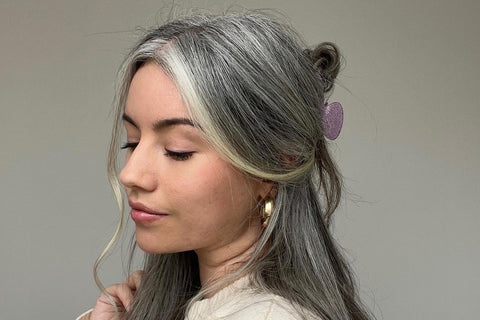The emergence of grey hair in young individuals is a phenomenon that arouses curiosity and reflection. Traditionally associated with wisdom and the passage of time, gray hairs at a young age challenge conventional expectations of beauty and youthfulness. This text explores the possible causes and diverse perceptions surrounding this phenomenon, highlighting the complexity and individuality behind this hair characteristic. By examining the reasons behind premature gray hair and the different attitudes towards them, we can better understand how our culture and beauty perceptions are constantly evolving.
But what are the possible causes of gray hair in youths? There are several potential causes for the emergence of grey hair at a young age:
- Genetics: Genetic predisposition plays a significant role in hair color. If there is a family history of premature grey hair, it is more likely that a person will develop it at a young age.
- Stress: Chronic stress can trigger a series of changes in the body, including the disruption of melanin production, the pigment that gives color to hair. This can lead to the premature appearance of gray hair.
- Nutritional Deficiencies: Lack of certain essential nutrients, such as vitamins B12 and D, iron, and copper, can affect hair health and contribute to its premature aging.
- Medical Conditions: Some medical conditions, such as alopecia areata (patchy hair loss), vitiligo (loss of skin and hair pigmentation), and thyroid disorders, can cause the appearance of gray hair at a young age.
- Environmental Factors: Exposure to harsh chemicals, environmental pollution, and ultraviolet radiation can also contribute to premature hair aging.
Although these are some of the possible causes, it is important to note that the emergence of gray hair at a young age may be influenced by a combination of genetic, environmental, and lifestyle factors. In many cases, the exact cause may be difficult to determine.

Can you do a progressive treatment on gray hair?
It is common for many women concerned about straightening their hair to be afraid of it turning yellow. If you share this concern, you are right, as most gray hairs tend to yellow after straightening procedures, such as progressive treatments or botox. This occurs due to the loss of melanin over the years, leaving the strands more vulnerable to sunlight radiation and heat from styling tools. To avoid this problem, it is essential to keep the hair strong and healthy with regular treatments. When doing the progressive treatment, some tips include using toners, controlling the temperature of the tools, and applying heat protectant. A good option is the Sorali, Silver Therapy, 1L developed especially for white and gray hair.
In addition, it is important to dry and brush the hair at medium temperature, avoiding excessive straightening to avoid damaging the strands. If intense yellowing occurs, it may be necessary to use toner or even bleach the hair, although this can be aggressive for those who prefer to keep the natural gray hair. In summary, it is essential to be cautious when straightening or reducing the volume of gray hair and carefully follow the guidelines to avoid yellowing and maintain hair health.
Therefore, when taking care of your gray hair during straightening procedures, always remember to prioritize the health and integrity of the strands. With proper care and the choice of specific products for gray hair, it is possible to enjoy straightening without worrying about yellowing. Stay informed about the best practices and products available on the market, and remember that true beauty lies in the confidence and well-being of each strand.

Buy now here
I'm full of gray hair and accepted the condition. How do I take care of it?
Caring for gray hair requires special attention to ensure they remain healthy, shiny, and beautiful. Here are some helpful tips:
- Regular hydration: Use a good conditioner or moisturizing mask for dry and damaged hair. This helps keep gray hair soft and malleable, avoiding them from appearing dull or brittle.
- Avoid dryness: Minimize the use of heat tools, such as dryers and straighteners, which can dry out the hair. If you need to use them, use a heat protectant to help protect the strands.
- Regular cutting: Get regular cuts to remove split ends and keep your hair looking healthy and well-groomed.
- Specific products for gray hair: Use products specifically formulated for white or gray hair, which help neutralize yellow tones and enhance the natural shine of the strands.
- UV protection: Protect your hair from the sun using hats or hair products with UV protection, especially if you spend a lot of time outdoors.
- Healthy diet: Maintain a balanced diet rich in vitamins and minerals, such as vitamin E, vitamin C, biotin, and omega-3, which are beneficial for hair health.
- Avoiding chemical products: Avoid excessive coloring or aggressive chemical treatments, as they can damage the hair and increase the appearance of gray hair.
- Gentle brushing: Use a natural bristle brush or a wide-tooth comb to detangle the hair gently, especially when wet, to avoid damage.

By following these tips and maintaining a consistent hair care routine, it is possible to keep gray hair looking healthy and radiant.
Keep enjoying our content here on the BBS blog.




